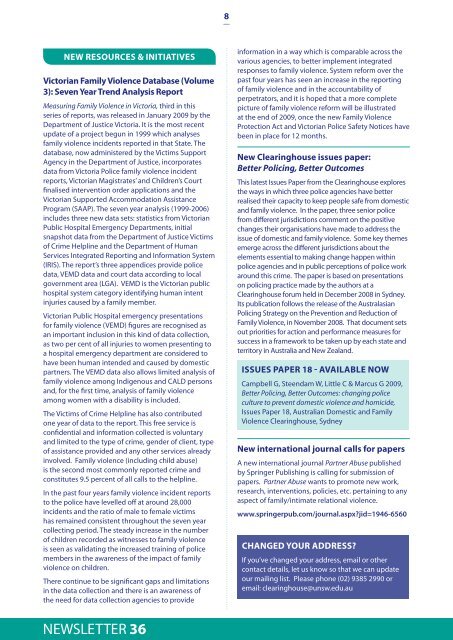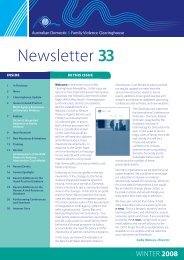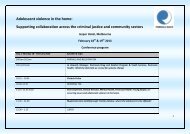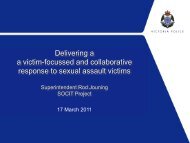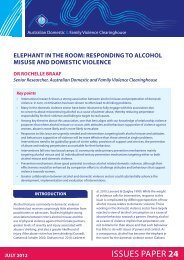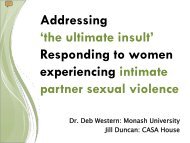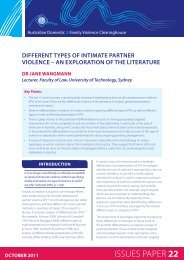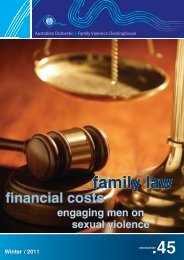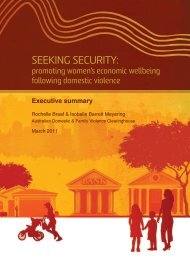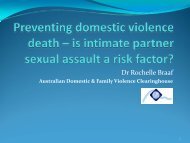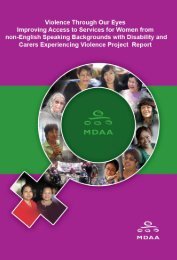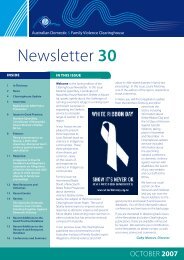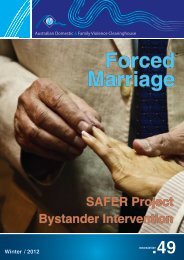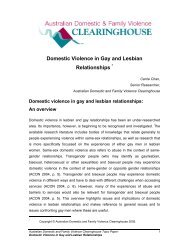newsletter - Australian Domestic and Family Violence Clearing House
newsletter - Australian Domestic and Family Violence Clearing House
newsletter - Australian Domestic and Family Violence Clearing House
You also want an ePaper? Increase the reach of your titles
YUMPU automatically turns print PDFs into web optimized ePapers that Google loves.
8<br />
NEW RESOURCES & INITIATIVES<br />
Victorian <strong>Family</strong> <strong>Violence</strong> Database (Volume<br />
3): Seven Year Trend Analysis Report<br />
Measuring <strong>Family</strong> <strong>Violence</strong> in Victoria, third in this<br />
series of reports, was released in January 2009 by the<br />
Department of Justice Victoria. It is the most recent<br />
update of a project begun in 1999 which analyses<br />
family violence incidents reported in that State. The<br />
database, now administered by the Victims Support<br />
Agency in the Department of Justice, incorporates<br />
data from Victoria Police family violence incident<br />
reports, Victorian Magistrates’ <strong>and</strong> Children’s Court<br />
finalised intervention order applications <strong>and</strong> the<br />
Victorian Supported Accommodation Assistance<br />
Program (SAAP). The seven year analysis (1999-2006)<br />
includes three new data sets: statistics from Victorian<br />
Public Hospital Emergency Departments, initial<br />
snapshot data from the Department of Justice Victims<br />
of Crime Helpline <strong>and</strong> the Department of Human<br />
Services Integrated Reporting <strong>and</strong> Information System<br />
(IRIS). The report’s three appendices provide police<br />
data, VEMD data <strong>and</strong> court data according to local<br />
government area (LGA). VEMD is the Victorian public<br />
hospital system category identifying human intent<br />
injuries caused by a family member.<br />
Victorian Public Hospital emergency presentations<br />
for family violence (VEMD) figures are recognised as<br />
an important inclusion in this kind of data collection,<br />
as two per cent of all injuries to women presenting to<br />
a hospital emergency department are considered to<br />
have been human intended <strong>and</strong> caused by domestic<br />
partners. The VEMD data also allows limited analysis of<br />
family violence among Indigenous <strong>and</strong> CALD persons<br />
<strong>and</strong>, for the first time, analysis of family violence<br />
among women with a disability is included.<br />
The Victims of Crime Helpline has also contributed<br />
one year of data to the report. This free service is<br />
confidential <strong>and</strong> information collected is voluntary<br />
<strong>and</strong> limited to the type of crime, gender of client, type<br />
of assistance provided <strong>and</strong> any other services already<br />
involved. <strong>Family</strong> violence (including child abuse)<br />
is the second most commonly reported crime <strong>and</strong><br />
constitutes 9.5 percent of all calls to the helpline.<br />
In the past four years family violence incident reports<br />
to the police have levelled off at around 28,000<br />
incidents <strong>and</strong> the ratio of male to female victims<br />
has remained consistent throughout the seven year<br />
collecting period. The steady increase in the number<br />
of children recorded as witnesses to family violence<br />
is seen as validating the increased training of police<br />
members in the awareness of the impact of family<br />
violence on children.<br />
There continue to be significant gaps <strong>and</strong> limitations<br />
in the data collection <strong>and</strong> there is an awareness of<br />
the need for data collection agencies to provide<br />
information in a way which is comparable across the<br />
various agencies, to better implement integrated<br />
responses to family violence. System reform over the<br />
past four years has seen an increase in the reporting<br />
of family violence <strong>and</strong> in the accountability of<br />
perpetrators, <strong>and</strong> it is hoped that a more complete<br />
picture of family violence reform will be illustrated<br />
at the end of 2009, once the new <strong>Family</strong> <strong>Violence</strong><br />
Protection Act <strong>and</strong> Victorian Police Safety Notices have<br />
been in place for 12 months.<br />
New <strong>Clearing</strong>house issues paper:<br />
Better Policing, Better Outcomes<br />
This latest Issues Paper from the <strong>Clearing</strong>house explores<br />
the ways in which three police agencies have better<br />
realised their capacity to keep people safe from domestic<br />
<strong>and</strong> family violence. In the paper, three senior police<br />
from different jurisdictions comment on the positive<br />
changes their organisations have made to address the<br />
issue of domestic <strong>and</strong> family violence. Some key themes<br />
emerge across the different jurisdictions about the<br />
elements essential to making change happen within<br />
police agencies <strong>and</strong> in public perceptions of police work<br />
around this crime. The paper is based on presentations<br />
on policing practice made by the authors at a<br />
<strong>Clearing</strong>house forum held in December 2008 in Sydney.<br />
Its publication follows the release of the Australasian<br />
Policing Strategy on the Prevention <strong>and</strong> Reduction of<br />
<strong>Family</strong> <strong>Violence</strong>, in November 2008. That document sets<br />
out priorities for action <strong>and</strong> performance measures for<br />
success in a framework to be taken up by each state <strong>and</strong><br />
territory in Australia <strong>and</strong> New Zeal<strong>and</strong>.<br />
Issues Paper 18 - available now<br />
Campbell G, Steendam W, Little C & Marcus G 2009,<br />
Better Policing, Better Outcomes: changing police<br />
culture to prevent domestic violence <strong>and</strong> homicide,<br />
Issues Paper 18, <strong>Australian</strong> <strong>Domestic</strong> <strong>and</strong> <strong>Family</strong><br />
<strong>Violence</strong> <strong>Clearing</strong>house, Sydney<br />
New international journal calls for papers<br />
A new international journal Partner Abuse published<br />
by Springer Publishing is calling for submission of<br />
papers. Partner Abuse wants to promote new work,<br />
research, interventions, policies, etc. pertaining to any<br />
aspect of family/intimate relational violence.<br />
www.springerpub.com/journal.aspxjid=1946-6560<br />
Changed your address<br />
If you’ve changed your address, email or other<br />
contact details, let us know so that we can update<br />
our mailing list. Please phone (02) 9385 2990 or<br />
email: clearinghouse@unsw.edu.au<br />
<strong>newsletter</strong> 36


